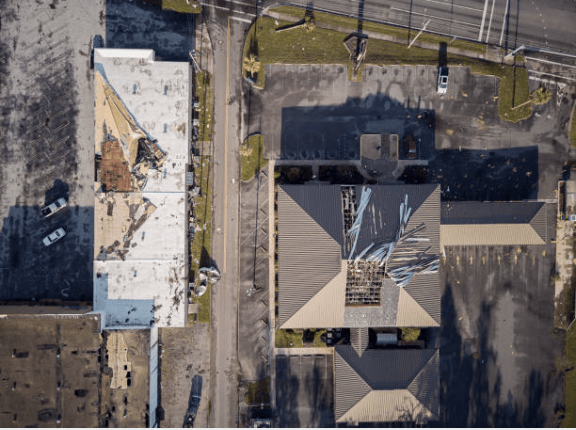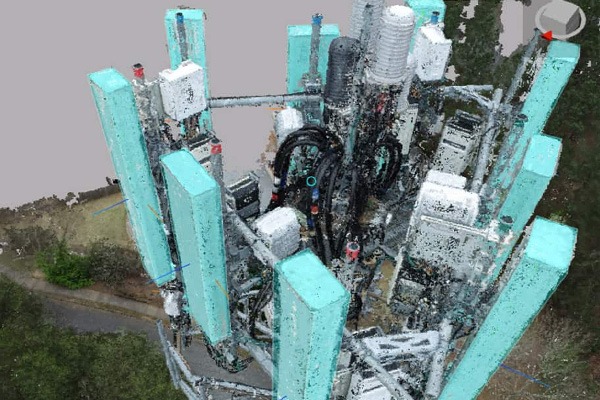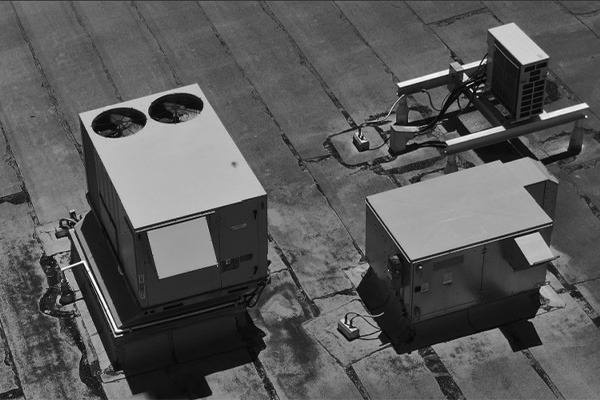Natural Disaster Inspection Management
The Critical Role of Digital Inspections in Preventative Maintenance for Facades & Roofs
Property managers are transitioning to digital inspections for facades and roofs in preventative maintenance to improve overall building longevity, tenant safety, and compliance with local regulations. Digital inspections provide accurate, real-time data, helping managers identify potential issues like leaks, cracks, and structural wear before they escalate into costly repairs.
This proactive approach reduces long-term maintenance costs, minimizes disruption to tenants, and ensures the property meets safety standards, ultimately preserving asset value and enhancing tenant satisfaction. Additionally, digital inspection records can streamline reporting for insurance and legal compliance.
Natural disasters like hurricanes, earthquakes, tornadoes, and floods cause significant damage to buildings and infrastructure, resulting in billions of dollars in losses each year. Preventative maintenance, particularly through digital inspections of facades and roofs, has become a game-changing tool for mitigating damage and streamlining recovery efforts. By leveraging this advanced technology, property managers can take a proactive approach to disaster preparedness, safeguarding their assets and ensuring tenant safety.
The Rising Costs of Natural Disasters
Natural disasters are on the rise globally, both in terms of frequency and severity. According to a report by the National Oceanic and Atmospheric Administration (NOAA), in 2020 alone, the U.S. experienced 22 separate billion-dollar weather and climate disasters, resulting in a cumulative cost of $95 billion. Facades and roofs are among the most vulnerable parts of a building during these extreme weather events. Storms, hurricanes, and high winds can strip roofs of their coverings, and expose inner structures to water damage and crack facades, leading to structural instability.
The Insurance Institute for Business & Home Safety (IBHS) reports that a well-maintained roof can reduce the chances of significant storm damage by up to 50%, and regular maintenance on building facades can also minimize the risk of serious issues following a disaster.
The Importance of Preventative Maintenance for Facades & Roofs
Preventative maintenance involves regularly assessing and addressing potential issues before they become critical problems. For property owners and managers, this means conducting regular inspections of facades and roofs to identify any vulnerabilities that natural disasters could exacerbate. Traditionally, these inspections are labor-intensive, time-consuming, and costly. However, advancements in digital inspection technologies, such as drones, 3D modeling, and artificial intelligence (AI)-driven analytics, have revolutionized this process.
1. Timely Detection of Issues
Digital inspections provide a faster, more accurate, and comprehensive view of a building’s structural health. For example, drones equipped with high-resolution cameras and sensors can quickly scan a building’s facade or roof, capturing data that is then analyzed using AI algorithms to detect cracks, leaks, or other issues invisible to the naked eye.
A study from the Harvard Joint Center for Housing Studies found that timely repairs can reduce long-term maintenance costs by up to 35%, while buildings that lack proper maintenance may experience 5-10% higher repair costs over time.
With early detection, property managers can make repairs before minor issues become major, saving time and money while also improving the building’s resilience to natural disasters.
2. Cost Savings through Predictive Maintenance
Predictive maintenance, powered by AI and machine learning, is a subset of preventative maintenance that allows property owners to predict when building components will fail. Using historical and real-time data gathered from digital inspections, predictive models can forecast the remaining lifespan of a roof or facade, allowing for repairs or replacements at optimal times.
The McKinsey Global Institute estimates that predictive maintenance can reduce maintenance costs by 20-30% and improve asset reliability by 20-50%. This capability is especially valuable in the context of natural disasters, where a roof or facade failure during a hurricane or earthquake can result in catastrophic damage.
The Role of Digital Inspections in Natural Disaster Management
When natural disasters strike, the condition of a building’s roof and facade can determine whether it sustains manageable damage or becomes a total loss. Digital inspections help property managers stay prepared in several critical ways:
1. Enhanced Documentation for Insurance & Recovery
Digital inspection technologies create detailed, timestamped records of a building’s condition before and after a natural disaster. This is crucial for insurance claims, as property owners can easily provide comprehensive evidence of damage, as well as demonstrate that the building was well-maintained before the event. According to J.D. Power’s U.S. Property Claims Satisfaction Study, claims satisfaction is 17% higher among policyholders who can provide clear evidence of damage and maintenance.
Moreover, the use of drones and 3D imaging can accelerate the insurance claims process by reducing the need for manual inspections, which are often delayed following large-scale disasters. Faster claims processing leads to quicker payouts, allowing property owners to start repairs sooner and minimize revenue losses.
2. Faster Damage Assessments Post-Disaster
After a natural disaster, access to damaged buildings may be limited due to safety concerns or structural instability. In such cases, drones can be deployed to assess damage without putting human inspectors at risk. Drones can capture aerial views of roofs, inspect facades, and even navigate tight spaces, providing property managers with a rapid assessment of the building’s condition.
According to PwC, drone-based assessments can reduce inspection time by 80-90% compared to traditional methods. In the aftermath of a disaster, this speed can be critical in coordinating repairs and preventing further damage, such as water infiltration through a compromised roof.
3. Proactive Disaster Preparedness
One of the key benefits of digital inspections is the ability to conduct regular assessments without significant downtime or disruptions. Drones and other technologies can be deployed quickly and efficiently, making it easier for property managers to maintain a consistent maintenance schedule.
This proactive approach is crucial in areas prone to natural disasters. For example, in hurricane-prone regions, property managers can use digital inspections to assess roofs and facades ahead of the storm season. By identifying and addressing vulnerabilities beforehand, they can significantly reduce the risk of damage when the storm hits. The Federal Emergency Management Agency (FEMA) recommends that property owners in disaster-prone areas conduct regular inspections to mitigate risk, and digital technologies make this task easier and more cost-effective.
Case Studies: How Digital Inspections Have Made a Difference
1. Hurricane Harvey (2017)
When Hurricane Harvey hit Texas in 2017, it caused more than $125 billion in damage, making it one of the costliest natural disasters in U.S. history. However, some property managers who had invested in digital inspection and preventative maintenance systems were able to mitigate the damage. For example, several commercial properties in Houston used drone-based roof inspections in the months leading up to the hurricane, identifying and repairing vulnerabilities. These buildings fared significantly better than others in the region, sustaining minimal damage compared to nearby structures that had not been inspected.
2. California Earthquake (2019)
In 2019, a series of earthquakes hit Southern California, causing widespread damage to buildings and infrastructure. In the aftermath, many property managers turned to drone technology to assess damage to facades and roofs, particularly in hard-to-reach areas. One property management company used drone-based 3D modeling to quickly evaluate the structural integrity of several buildings, allowing them to prioritize repairs and minimize downtime. This technology also helped them document damage for insurance claims, leading to faster settlements.
Future Trends in Digital Inspections & Preventative Maintenance
As digital inspection technologies continue to evolve, property managers can expect even more advanced tools for maintaining their buildings and preparing for natural disasters. Technologies like LiDAR (Light Detection and Ranging), thermal imaging, and AI-driven predictive analytics will further enhance the accuracy and efficiency of inspections. These innovations will allow property management teams to pinpoint even the smallest vulnerabilities in facades and roofs, ensuring that their buildings are as disaster-resistant as possible.
The global market for drone-based inspections is expected to grow from $9.5 billion in 2020 to $23 billion by 2027, according to a report by Fortune Business Insights, and as costs decrease and capabilities expand, digital inspections will become an essential tool for every property manager focused on long-term resilience and disaster preparedness.
Embracing Digital Inspections for a Safer Future
Natural disasters pose an ever-present threat to property owners and managers, but by adopting digital inspections as part of a robust preventative maintenance strategy, they can significantly reduce their risk. From cost savings and faster repairs to better disaster preparedness and improved insurance outcomes, the benefits of digital inspections are clear. By leveraging these technologies, property managers can not only protect their assets but also ensure safety when disaster strikes.
Proactive maintenance and the use of digital inspection technology will play a pivotal role in creating resilient buildings capable of withstanding the increasing challenges posed by natural disasters.
To learn more about Pointivo’s AI-driven platform and reporting capabilities, contact us at team@pointivo.com.
Don’t forget to share this post!
[tags]






